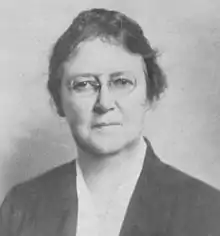Mabel Augusta Chase
Mabel Augusta Chase (October 11, 1865 – March 31, 1939) was an American physicist and university professor.
Mabel Augusta Chase | |
|---|---|
 Chase, as a professor at Mount Holyoke College (1906–1933) | |
| Born | October 11, 1865 |
| Died | March 31, 1939 (aged 73) |
| Alma mater | Oberlin College, Cornell University |
| Scientific career | |
| Fields | Physics |
| Institutions | Mount Holyoke College |

Biography
Early life
Mabel Augusta Chase was born on October 11, 1865, in Lyndonville, New York.[1] Her parents were Julia Augusta Spence and Frederick Augustus Chase.[1] She was born as the eldest of five children, with only her two younger brothers surviving past childhood.[1]
Her father was a Presbyterian clergyman and minister as well as a professor of natural science.[2] He taught at Fisk University, a historically black university, in Nashville and was also president of Lyons Female College in Clinton, Iowa.[2] Both his passion for science and knack for teaching were passed onto his daughter, Mabel, who came to study physics.[1]
Education
Chase attended Oberlin College from 1886 to 1888 and graduated with a degree in physics.[3] She then attended Cornell University, where she obtained her master's degree[1] and her PhD,[4] finishing in 1890. She wrote her dissertation on a subject that would be a common interest throughout her life: light. Specifically, the writing studied optics and the relationship between the shape of the human eye and the perception of color.[4]
Career
After her studies, Chase became a teacher. She taught at Wellesley College,[5] Mount Holyoke College,[6] and other Massachusetts area schools[3] until she became an associate professor at Mount Holyoke in 1906.[7] She was a professor at Mount Holyoke from 1906 to 1933 and achieved the title of Professor Emeritus.[8] She was seen as the second in command of the physics department[9] during her time and mentored students and other professors.[10] Students described her as not very organized but very understanding and a good teacher.[9]
In addition to teaching, she conducted research and published her findings.[11] Her work throughout her career was varied but mostly centered around research and advancements in light and color.[11] Scientific journals published some of her work on light and iridescence.[12] Her work on advanced topics in physics[13] took her to other institutions, including the University of Chicago and the Imperial College of London.[1]
Along her own research, she also worked closely with Sarah Frances Whiting in establishing a physics laboratory at Wellesley College and investigating x-rays.[14] Their experiments were based on newly published work by German scientist Wilhelm Röntgen.[14] They used the same equipment which included a Crookes tube, an induction coil,[15] a battery, glass plates and holders, and photographic chemicals to produce "shadow photographs" or x-ray images.[14] While experimenting, they varied the objects examined, the timing of the photograph, and the materials used, in order to improve image quality and learn how x-rays would penetrate materials of different material and makeup.[14]
During her life and career, Chase was a member of various esteemed organizations related to her academic endeavors.[1] She was a member of the American Physical Society, the American Association for the Advancement of Science, the American Association of University Women, and the Foreign Policy Association.[1]
Later life and legacy
Chase retired from Mount Holyoke College in 1933.[8] She died on March 31, 1939, after being injured in a car accident.[16] Like her father before her, Chase was buried in Nashville, Tennessee.[2][16] She remains regarded as one of the most active and knowledgeable woman scientists in the field of physics during the early 20th century.[17]
References
- "FamilySearch.org". ancestors.familysearch.org. Retrieved 2023-06-15.
- "Frederick A. Chase Papers | RBSCP". rbscp.lib.rochester.edu. Retrieved 2023-06-15.
- Oberlin College (1909). ... General catalogue of Oberlin college, 1833 [-] 1908. Including an account of the principal events in the history of the college, with illustrations of the college buildings. University of California Libraries. Oberlin, O., Oberlin college.
- Chase, Mabel Augusta. "The Fundamental Colour Curves of the Human Eye." PhD diss., Cornell University, 1890.
- Wellesley Junior Class. Legenda. Wellesley, MA: Wellesley College, 1897. https://repository.wellesley.edu/islandora/object/wellesley%3A610/datastream/OBJ/download.
- Scrapbook Page with Mabel Chase and Sarah Frances Whiting. Photograph. Wellesley, 1900. Wellesley College. JSTOR community.23026268
- “University and Educational News.” Science 24, no. 614, October 5, 1906. doi:10.1126/science.24.614.448
- "Mabel Augusta Chase". 2014-10-03. Archived from the original on 2014-10-03. Retrieved 2023-06-15.
- Physics, American Institute of (2021-09-24). "Lucy Wilson - Session I". www.aip.org. Retrieved 2023-06-15.
- "Collection: Mildred Allen papers | Mount Holyoke and Hampshire College archives". aspace.fivecolleges.edu. Retrieved 2023-06-15.
- Ogilvie, Marilyn Bailey. Women in Science: Antiquity through the Nineteenth Century: A Biographical Dictionary with Annotated Bibliography. London: The MIT Press, 1986. ISBN 978-0-262-15031-6, 978-0-262-65038-0.
- Chase, Mabel A. “Iridescent Clouds.” Science 55, no. 1419, March 10, 1922. doi:10.1126/science.55.1419.263
- Gornick, Vivian. Women in Science: Then and Now. New York: The Feminist Press at The City University of New York, 2009. ISBN 978-1-55861-587-8, 978-1-55861-594-6.
- Cameron, John S, and Jacqueline Marie Musacchio. “Sarah Frances Whiting and the ‘Photography of the Invisible.’” Physics Today 73, no. 8, August 2020. doi:10.1063/PT.3.4545
- Wietfeldt, Fred E. “Whiting’s Notes on Induction-Coil Size.” Physics Today 74, no. 1, January 2021. doi:10.1063/PT.3.4647
- Special to The New York Times (1939-04-02). "Mabel Chase Dies; Physics Teacher; Was Professor Emeritus at Mt. Holyoke--Succumbs to Auto Injuries in South". The New York Times. ISSN 0362-4331. Retrieved 2023-06-15.
- Wróblewski, Andrzej K. “Physics 1909: A Portrait of the Field 100 Years Ago.” Acta Physica Polonica B 41, no. 2 (n.d.): 229–48. https://www.actaphys.uj.edu.pl/fulltext?series=Reg&vol=41&page=229.